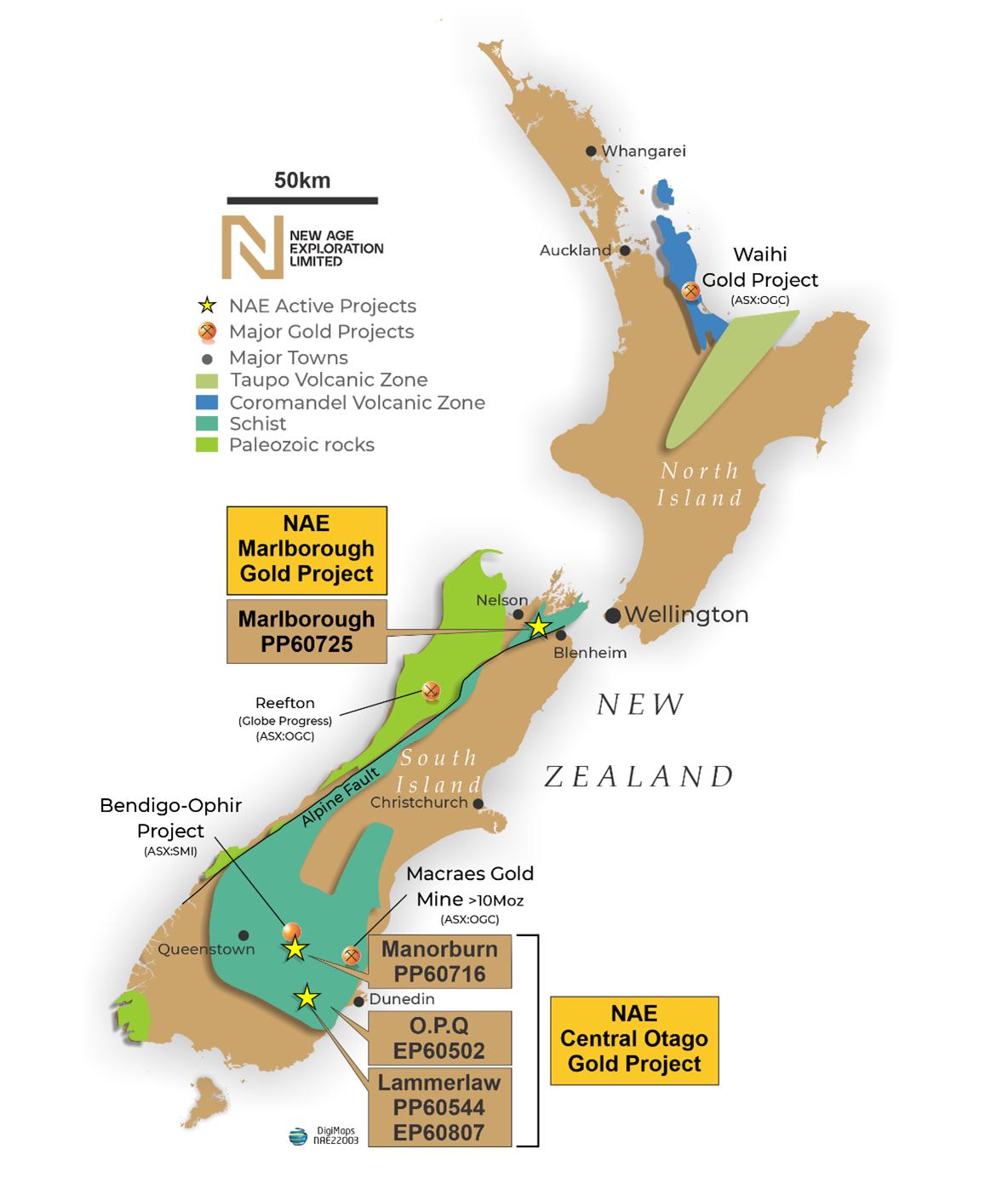- NAE expands its strategic landholding in New Zealand following the granting of 499km2 Prospecting Permit PP60725 over the Company’s 100% owned Marlborough Gold Project in August 2022
- This expands and consolidates NAE’s position as a leading explorer in New Zealand
- Additional projects include Lammerlaw, Manorburn, and OPQ projects advanced Gold exploration with high priority drill targets progressing (Refer Figure 1)
- The Marlborough Permit exhibits the same sequence of geology which hosts the ‘Rise and Shine’ Shear Zone forming part of the Santana (ASX:SMI) Minerals Bendigo-Ophir Project and Oceana Gold’s (ASX:OGC) Macraes gold mine that have a combined production and Minerals Resource in excess of 10Moz gold
- The Manorburn project adjoins Santana Minerals (ASX:SMI) the +2Moz JORC Resource ‘Rise and Shine’ project
- The Marlborough Permit is underexplored and highly prospective with compelling targets, including historically productive hard-rock gold mines with little to no modern exploration methods applied
- An initial work program involving a geophysical review, mapping, rock chip and soil sampling is scheduled in tandem with NAE’s further exploration of its Otago permits
Overview
NAE’s Marlborough Prospecting permit is located between Nelson and Blenheim, on the north-western side of the Alpine Fault – a regional significant structure dividing the South Island into two related geological portions. The highly prospective Central Otago Schist/Gold Belt is offset by the Alpine Fault, the continuation known as the Marlborough Schist underlies the Marlborough Permit area. Recent discoveries by Santana Minerals at the Bendigo-Ophir Gold Project and the World Class Macraes Gold Mine, owned and operated by Oceana Gold highlight the gold endowment of the South Island schist belt.
NAE considers the Marlborough permit to potentially host structurally controlled orogenic gold mineralisation similar to the bulk tonnage Macraes and Bendigo-Ophir deposits, as well as high-grade quartz lode gold systems seen elsewhere in the Otago Goldfield. The Marlborough permit contains analogous rock types and was subject to the same geological setting during episodes of mineralisation in Otago. Despite this potential, no systematic ground-based exploration methodology has been applied to the Marlborough Permit area, with prior explorers collecting scattered surface samples and airborne geophysics.
Four significant gold/tungsten occurrences are recorded within the Marlborough Permit areas (Refer Figure 2). All were first prospected in the late 1800’s, highlights include:
Wakamarina Goldfield was an epicentre of New Zealand’s gold rush in 1860’s. As alluvial gold was exhausted, hard rock gold and tungsten mining commenced. The largest mine was the Golden Bar/Empire City vein system. Production record is patchy, with average recovered grades of 4g/t gold and 0.5% tungsten recorded. Notably, during mining the focus was tungsten production, with much of the gold lost during processing. Mining occurred over a strike of 850m and depths down 100m over four levels. Since the abandonment of the site in the 1940’s, no drilling or significant on-the ground exploration has taken place. The Golden Bar/Empire City vein system represents and outstanding exploration target.
Top Valley Gold Field, which contains six or more historic quartz lodes with minor historic production are clustered in 1km x 4km NW trending area. The Top Valley NW trending mineralised structures have similarities to structurally controlled bulk tonnage orogenic gold systems seen in Otago (Macraes and Bendigo-Ophir). Gridded sampling across mineralised structures will be used to assess the tenure of Top Valley.
Sutherlands Reef is gold bearing quartz vein briefly mined 1870 to 1880s with results up to 30g/t Gold. Limited modern sample shown gold grades up to 31.42g/t gold. More field work is required to understand the prospectivity of Sutherlands.
Waikakaho field contains gold and tungsten occurrences associated with quartz lodes contained within a pelitic schist unit. Trial mining was unsuccessfully in the late 1800’s due to poor recovery. Geophysical review and further surface sampling will be used to assess the value of this area.





